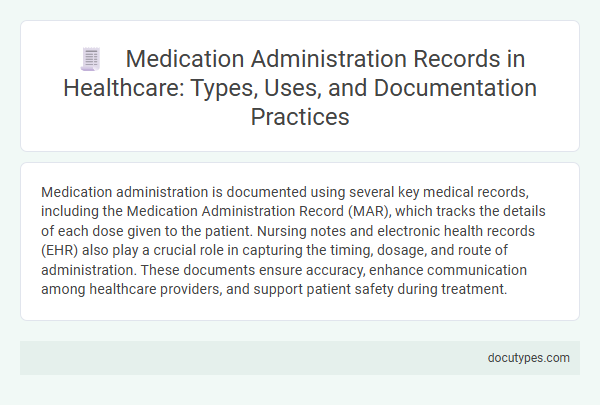Medication administration is documented using several key medical records, including the Medication Administration Record (MAR), which tracks the details of each dose given to the patient. Nursing notes and electronic health records (EHR) also play a crucial role in capturing the timing, dosage, and route of administration. These documents ensure accuracy, enhance communication among healthcare providers, and support patient safety during treatment.
Introduction to Medication Administration Records (MAR)
Medication Administration Records (MAR) are essential documents in healthcare settings for accurately recording the administration of medications to patients. These records ensure that healthcare providers follow correct dosages, timing, and routes of administration, promoting patient safety and accountability.
- Medication Administration Record (MAR) - A detailed chart used to document each dose of medication given to a patient, including time, dosage, and administration method.
- Physician's Orders - Official prescriptions and instructions from doctors that guide medication administration and are referenced on the MAR.
- Nursing Progress Notes - Records maintained by nursing staff that provide supplementary information on patient response and any adverse reactions related to medication administration.
Importance of Accurate Documentation in Medication Management
Accurate documentation in medication administration is crucial for ensuring patient safety and effective treatment outcomes. Key documents include medication administration records (MAR), electronic health records (EHR), and patient charts that track dosages and timing.
Your ability to reference these records reduces errors and supports clear communication among healthcare providers. Proper documentation verifies that medications are given as prescribed and helps identify any adverse reactions promptly.
Types of Medication Administration Records
Medication administration documentation is essential for ensuring patient safety and accurate treatment. Your healthcare team relies on various types of records to track medication delivery effectively.
- Paper Medication Administration Record (MAR) - A traditional physical document used to log medication types, dosages, and administration times manually.
- Electronic Medication Administration Record (eMAR) - A digital system that improves accuracy and accessibility by electronically tracking medication details in real-time.
- Controlled Substance Record - Specialized documentation used to monitor the administration and inventory of controlled medications, ensuring regulatory compliance.
Paper-Based vs. Electronic MARs
Medication Administration Records (MARs) document the administration of medications to patients, ensuring accuracy and accountability in medical settings. These records are essential for tracking dosage, timing, and adherence to prescription orders.
Paper-based MARs involve handwritten logs where healthcare providers manually record medication details, which may lead to errors due to illegibility or incomplete entries. Electronic MARs (eMARs) offer digital solutions that improve accuracy by integrating with electronic health records and providing automatic alerts for medication schedules. eMARs enhance patient safety through real-time updates and reduce the risk of missed or incorrect doses.
Essential Components of Medication Administration Records
Medication administration records (MARs) are essential documents used to document the details of medications given to patients. These records ensure accurate tracking of drug administration and help prevent errors in healthcare settings.
Essential components of MARs include patient identification, medication name, dosage, route, and time of administration. Your healthcare team relies on these details to maintain proper medication management and ensure patient safety.
Roles and Responsibilities in MAR Documentation
Which documents are essential for recording medication administration in clinical settings? Medication Administration Records (MAR) serve as the primary tool for documenting the details of medication given to patients. These records ensure accuracy, track dosage schedules, and maintain patient safety through clear documentation.
Who holds the responsibility for accurate MAR documentation in healthcare environments? Nurses and authorized healthcare professionals are primarily accountable for recording medication administration in the MAR. Their role includes verifying medication orders, documenting the time and dosage, and noting any patient reactions or refusals.
Common Errors in Medication Administration Records
Medication Administration Records (MARs), prescription orders, and electronic health records (EHRs) are commonly used documents for recording medication administration. Common errors in these records include incorrect dosage, omissions, and timing discrepancies. Ensuring accuracy in Your medication administration documentation is crucial for patient safety and effective treatment outcomes.
Best Practices for Maintaining MARs
Medication Administration Records (MARs) are essential documents used to accurately record the administration of medications in healthcare settings. Maintaining precise and up-to-date MARs ensures patient safety and compliance with medical protocols.
- Handwritten MARs - These traditional records require clear, legible entries to prevent medication errors and ensure accurate tracking.
- Electronic MARs (eMARs) - Digital systems offer real-time updates and integration with patient records, enhancing accuracy and accessibility.
- Double-Check Documentation - Verifying entries with a second healthcare professional reduces errors and improves reliability of medication records.
Your adherence to best practices in maintaining MARs supports optimal patient care and medication safety.
Legal and Regulatory Considerations for MAR Documentation
| Document Type | Purpose | Legal and Regulatory Considerations |
|---|---|---|
| Medication Administration Record (MAR) | Primary document for recording medication administration details including drug name, dosage, route, time, and administrator's signature. | Must comply with healthcare facility policies and regulatory bodies such as the Joint Commission; accuracy and timeliness are legally required to ensure patient safety and accountability. |
| Electronic Medication Administration Record (eMAR) | Digital version of MAR allowing automated checks for drug interactions and allergies. | Compliance with HIPAA for patient privacy, FDA regulations for electronic records, and local laws ensuring data integrity and audit trails. |
| Physician's Orders | Written or electronic prescriptions directing medication use. | Legal necessity for documenting clear, authorized medication instructions; must be reviewed and signed according to regulatory standards. |
| Pharmacy Records | Documentation of medication dispensing and inventory control. | Required by state pharmacy boards and federal law to track controlled substances and ensure proper dispensing practices. |
| Incident Reports | Records of medication errors or adverse reactions. | Mandated by healthcare regulations to document and analyze errors for quality improvement and legal protection. |
Your adherence to legal and regulatory guidelines in maintaining MAR documentation ensures patient safety, accountability, and compliance with healthcare standards.
Which Documents Are Used for Recording Medication Administration? Infographic

